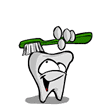
Pedodontic Dentistry or Pedodontics applies to the field of dentistry related with the care of children's teeth. Preventive dentistry is usually applied in the field of pedodontics in teaching and promoting good oral care and preventing tooth decay in children.
What To Do in Case of an Emergency?
What To Do in Case of an Emergency?

One of the most important things you can do as a parent to protect these precious baby teeth is to make sure that you are prepared before an accident even occurs. In our dental practice, the most common dental emergencies we encounter are
Time is the enemy when a tooth is knocked out. If a dentist is seen within one hour after an accident, chances are good that the tooth can be re-implanted and saved. Remember to rinse the tooth off and place the tooth into a cup of saliva or milk. See a dentist immediately.

With chipped teeth the situation is slightly more complicated. If the your child is experiencing pain or sensitivity in the affected tooth, consult dentist immediately as this indicates the tooth nerve may be injured. The dentist can perform a root canal or other necessary procedures to save the tooth. Afterwards, a porcelain crown or bonding material can be sculpted onto the tooth to replace the lost portion.
With chipped teeth the situation is slightly more complicated. If the your child is experiencing pain or sensitivity in the affected tooth, consult dentist immediately as this indicates the tooth nerve may be injured. The dentist can perform a root canal or other necessary procedures to save the tooth. Afterwards, a porcelain crown or bonding material can be sculpted onto the tooth to replace the lost portion.

For a parent, seeing a child lose a tooth in an accident can be gut wrenching. Such injuries are often bloody and can be anxiety provoking for the child as well. Knowing how to prevent dental injury and what to do in case your child's teeth are damaged in an accident can save your children's teeth. All teeth, even baby teeth, are important. Many parents, are under the mis-impression that baby teeth are less important because they will eventually be replaced.
This is absolutely not true. Baby teeth serve several important functions including, acting as spacers creating enough room in the jaw so that permanent teeth can come in, aiding in proper speech development, and serving to help build self-esteem in the newly independent child.
Careful rinse the tooth in water. Make sure that you do not touch the root of the tooth with your hands. The root is the portion of the tooth which is usually embedded in the gum and not normally seen.
Attempt to place the tooth back in its socket and secure with a wet wrap. If this is not possible or if you are afraid that your child might swallow the tooth, place it in a glass containing either saliva or milk. See your dentist immediately.
Check to see if your child is experiencing pain or sensitivity in the tooth. If so call your dentist and seek dental treatment immediately.
If your child is not experiencing pain or sensitivity, contact your dentist to see whether or not your child should be seen. In most cases, this will not require immediate attention and your dentist will schedule your child for an appointment to be seen.
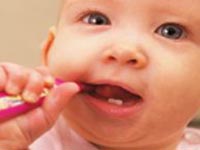
Watch out for situations that commonly can lead to dental injury. In our practice these are some of the more common: Trips and Falls - Falling into furniture and down stairs often causes dental injury. This is most likely to occur when children are first learning to stand and often use furniture to maintain balance.Children who are just learning to walk also have a tendency to fall down - often onto household furniture or other items. If you have an infant make sure to child proof your home before they become mobile - usually around 12 - 16 months.
Forks and Spoons - Believe it or not, some injuries are self-inflicted when people, not paying attention, crack or chip their teeth with spoons or forks as they eat Bottle Caps - Tell you child never attempt to open a bottle cap by using their teeth.
Did you know that proper dental care begins in the womb ? A baby's teeth begin to form six weeks after conception. Inadequate eating habits by mothers, however, can cause failure of the tooth enamel to form. This, in turn, can cause your child to be extremely susceptible to cavity formation. Expectant mothers should remember to eat a well-balanced diet and consume products which contain the calcium necessary for proper fetal bone and tooth formation.
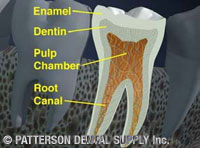
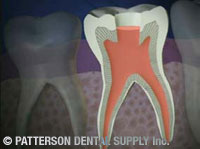

When the nerve of a baby tooth becomes infected, a pulpectomy can save the tooth. Like a root canal in an adult tooth, a pulpectomy involves removal of the infected nerve and the placement of a filling material.Four steps to a pulpectomy Though treatment is individualized in each case, there are four common steps in a pulpectomy. First, an opening is made into the tooth to get at the infection. Then the infected nerve tissue is removed. A filling material is placed in the root canals, and then a crown is placed to seal and protect the tooth.
We want the entire procedure to be comfortable for your child, so the first thing we do is make sure her mouth is thoroughly numb. We place a rubber dam around the tooth to isolate it from the rest of the mouth. It protects her like a safety net: Nothing can fall to the back of her throat.
To get at the infection, we make an opening through the top of the tooth down into the pulp chamber. We carefully clean out the infected tissue and then place a filling material. The last step in the procedure is the placement of a crown to seal and protect the tooth.
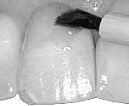
Fluoride varnish provides the most effective way of topical fluoride application on a child's teeth. Fluoride varnishes prevent and even reverse early childhood caries. They have proven efficacy in reducing cavities in both primary and permanent teeth.
Fluoride varnish provides the most effective way of topical fluoride application on a child's teeth. Fluoride varnishes prevent and even reverse early childhood caries. They have proven efficacy in reducing cavities in both primary and permanent teeth.
The top surfaces of your teeth - where the chewing takes place - aren't smooth and flat. They are cris-crossed with tiny hills and valleys - called pits and fissures. These are places where plaque can build up safe from your toothbrush and dental floss. Some of the pits and fissures are so narrow that even a single bristle from your toothbrush can't get deep enough to clean them out.
One method of preventing cavities from developing in the pits and fissures is to seal them off with a special varnish called a pit and fissure sealant. If your dentist determines that you need a pit and fissure sealant to help protect your teeth from decay, some special steps are taken to prepare the teeth first. Your dentist will clean the tooth first, then apply a mild acid solution to 'etch' the surface and make it easier for the pit and fissure sealant to stick. (The etching solution is the blue gel in the sealant video below). The whole procedure is quick and painless. Keeping the area dry and away from your saliva during the application is very important. If the tooth gets wet, the sealant might not stick properly. Once everything is ready, your dentist 'paints' the sealant right over the pits and fissures on the tooth surface. (Do you see it being painted on with a cotton swab in the video). A special kind of light cures the sealant and makes it ready for use.
